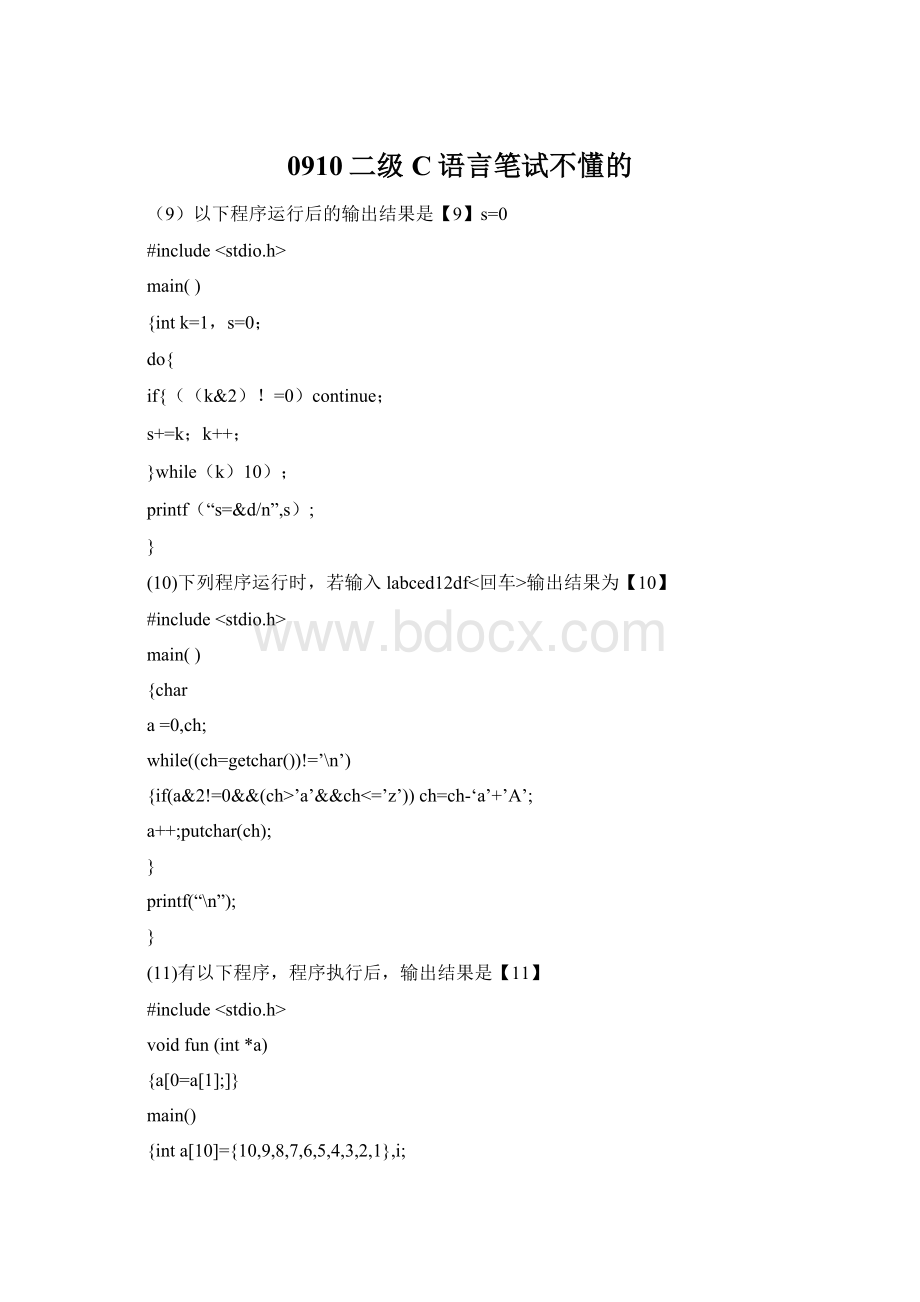0910二级C语言笔试不懂的.docx
《0910二级C语言笔试不懂的.docx》由会员分享,可在线阅读,更多相关《0910二级C语言笔试不懂的.docx(12页珍藏版)》请在冰豆网上搜索。

0910二级C语言笔试不懂的
(9)以下程序运行后的输出结果是【9】s=0
#include
main()
{intk=1,s=0;
do{
if{((k&2)!
=0)continue;
s+=k;k++;
}while(k)10);
printf(“s=&d/n”,s);
}
(10)下列程序运行时,若输入labced12df<回车>输出结果为【10】
#include
main()
{char
a=0,ch;
while((ch=getchar())!
=’\n’)
{if(a&2!
=0&&(ch>’a’&&ch<=’z’))ch=ch-‘a’+’A’;
a++;putchar(ch);
}
printf(“\n”);
}
(11)有以下程序,程序执行后,输出结果是【11】
#include
voidfun(int*a)
{a[0=a[1];]}
main()
{inta[10]={10,9,8,7,6,5,4,3,2,1},i;
for(i=2;i>=0;i--)fun{&a};
for(i=0;i<10;i++)printf(“&d”,a);
printf(“\n”);
}
(14)下列程序的运行结果为【14】1001,ChangRong,1098.0
#include
#include
structA
{inta;charb[10];double
c;};
void
f(struct
A
*t);
main()
{structAa=(1001,”ZhangDa”,1098,0);
f(&a);printf(“&d,&s,&6,if\n”,a.a,a.b,a.c);
}
voidf(struct
A
*t)
{strcpy(t->b,”ChangRong”);
}
(15)以下程序把三个NODETYPE型的变量链接成一个简单的链表,并在while循环中输出链表结点数据域中的数据,请填空
#include
structnode
{intdata;structnode*next;};
typedefstructnodeNODETYPE;
main()
{NODETYPEa,b,c,*h,*p;
a.
data=10;b.data=20;c.data=30;h=&a;
b.
next=&b;b.next=&c;c.next=’\0’;
p=h;
while(p){printf(“&d”,p->data);【15】p=p—>next;}
C(24)有以下程序
#include
void fun(int p)
{ int d=2;
p=d++;
printf("%d",p);
}
main()
{ int a=1;
fun(a);
printf("%d\n",a);
}
程序运行后的输出结果是
A)32
B)12
C)21
D)22
D(25)以下函数findmax拟实现在数组中查找最大值并作为函数值返回,
但程序中有错导致不能实现预定功能
#define MIN -
int findmax(int x[],int n)
{ int i,max;
for(i=0;i { max=MIN;
if(max }
return max;
}
造成错误的原因是
A)定义语句int i,max中max未赋值
B)赋值语句max=MIN;中,不应该给max赋MIN值
C)语句if(maxD)赋值语句max=MIN;放错了位置
A(27)若有定义语句:
int a[4][10],*p,*q[4];且0<=i<4,则错误的赋值是
A)p=a
B)q[i]=a[i]
C)p=a[i]
D)p=&a[2][1]
A(33)设有以下函数:
void fun(int n,char *s){……}
则下面对函数指针的定义和赋值均正确的是
A)void (*pf)(); pf=fun;
B)void *pf(); pf=fun;
C)void *pf(); *pf=fun;
D)void (*pf)(int,char);pf=&fun;
C(34)有以下程序
#include
int f(int n);
main()
{ int a=3,s;
s=f(a);s=s+f(a);printf("%d\n",s);
}
int f(int n)
{ static int a=1;
n+=a++;
return n;
}
程序运行后的输出结果是
A)7
B)8
C)9
D)10
B(36)下面结构体的定义语句中,错误的是
A)struct ord {int x;int y;int z;};struct ord a;
B)struct ord {int x;int y;int z;} struct ord a;
C)struct ord {int x;int y;int z;} n;
D)struct {int x;int y;int z;} a;
D(38)有以下程序
#include
struct A
{ int a;char b[10];double c;};
struct A f(struct A t);
main()
{ struct A a={1001,"ZhangDa",1098.0};
a=f(a); printf("%d,%s,%6.1f\n",a.a,a.b,a.c);
}
struct A f(struct A t)
{ t.a=1002;strcpy(t.b,"ChangRong");t.c=1202.0;return t;}
程序运行后的输出结果是
A)1001,ZhangDa,1098.0
B)1002,ZhangDa,1202.0
C)1001,ChangRong,1098.0
D)1002,ChangRong,1202.0
(8)以下程序运行后的输出结果是【8】
#include
main()
{ int x=20;
printf("%d ",0 printf("%d\n",0}
输入答案,中间不含空格:
(9)以下程序运行后的输出结果是【9】
#include
main()
{ int a=1,b=7;
do{
b=b/2;a+=b;
} while (b>1);
printf("%d\n",a);
}
输入答案,中间不含空格:
(10)有一下程序
#include
main()
{ int f,f1,f2,i;
f1=0;f2=1;
printf("%d %d ",f1,f2);
for(i=3;i<=5;i++)
{ f=f1+f2; printf("%d",f);
f1=f2; f2=f;
}
printf("\n");
}
程序运行后的输出结果是【10】
输入答案,中间不含空格:
(11)有以下程序
#include
int a=5;
void fun(int b)
{ int a=10;
a+=b; printf("%d",a);
}
main()
{ int c=20;
fun(c); a+=c; printf("%d\n",a);
}
程序运行后的输出结果是【11】
输入答案,中间不含空格:
(12)设有定义
struct person
{ int ID;char name[12];} p;
请将scanf("%d",【12】);语句补充完整,使其能够为结构体变量p的
成员ID正确读入数据。
输入答案,中间不含空格:
(14)有以下程序
#include
typedef struct
{ int num;double s;} REC;
void fun1(REC x){ x.num=23;x.s=88.5; }
main()
{ REC a={16,90.0};
fun1(a);
printf("%d\n",a.num);
}
输入答案,中间不含空格:
(15)有以下程序
#include
fun(int x)
{ if(x/2>0) fun(x/2);6,3,
printf("%d ",x);
}
main()
{ fun(6);printf("\n");}
程序运行后的输出结果是【15】
(36)有以下程序
#include<stdio.h>
intfun()
{staticintx=1;
x+=1;returnx;
}
main()
{inti;s=1;
for(i=1;i<=5;i++)s+=fun();
printf(”%d\n”,s);
}
程序运行后的输出结果是
A)11
B)21
C)6
D)120(37)有以下程序
#inctude<stdio.h>
#include<stdlib.h>
Main()
{int*a,*b,*c;
a=b=c=(int*)malloc(sizeof(int));
*a=1;*b=2,*c=3;
a=b;
printf(“%d,%d,%d\n”,*a,*b,*c);
}
程序运行后的输出结果是
A)3,3,3B)2,2,3C)1,2,3D)1,1,3
(38)有以下程序
#include<stdio.h>
main()
{ints,t,A=10;doubleB=6;
s=sizeof(A);t=sizeof(B);
printf(“%d,%d\n”,s,t);
}
在VC6平台上编译运行,程序运行后的输出结果是
A)2,4B)4,4C)4,8D)10,6
(39)若有以下语句
TypedefstructS
{intg;charh;}T;
以下叙述中正确的是
A)可用S定义结构体变量
B)可用T定义结构体变量
C)S是struct类型的变量
D)T是structS类型的变量
(40)有以下程序
#include<stdio.h>
main()
{shortc=124;
c=c_______;
printf(“%d\n”、C);
}
若要使程序的运行结果为248,应在下划线处填入的是
A)>>2B)|248C)&0248D)< 请将每空的正确答案写在答题卡【1】至【15】序号的横线上,答在试卷上不得分。
(1)一个栈的初始状态为空。
首先将元素5,4,3,2,1依次入栈,然后退栈一次,再将元素A,B,C,D依次入栈,之后将所有元素全部退栈,则所有元素退栈(包括中间退栈的元素)的顺序为【1】
(2)在长度为n的线性表中,寻找最大项至少需要比较【2】次。
(3)一棵二叉树有10个度为1的结点,7个度为2的结点,则该二叉树共有【3】个结点(4)仅由顺序、选择(分支)和重复(循环)结构构成的程序是【4】程序。
(5)数据库设计的四个阶段是:
需求分析,概念设计,逻辑设计【5】。
(6)以下程序运行后的输出结果是【6】。
#include<stdio.h>
main()
{inta=200,b=010;
printf(”%d%d\n”,a,b);
}
(7)有以下程序
#include<stdio.h>
main()
{intx,Y;
scanf(”%2d%ld”,&x,&y);printf(”%d\n”,x+y);
}
程序运行时输入:
程序的运行结果是【7】。
(8)在C语言中,当表达式值为0时表示逻辑值“假”,当表达式值为【8】时表示逻辑值“真”。
有以下程序
#include<stdio.h>
main()
{inti,n[]={0,0,0,0,0};
for(i=1;i<=4;i++)
{n[i]=n[i-1]*3+1;printf(”%d",n[i]);}
}
程序运行后的输出结果是【9】。
(10)以下fun函数的功能是:
找出具有N个元素的一维数组中的最小值,并作为函数值返回。
请填空。
(设N已定义)
intfun(intx[N])
{inti,k=0;
for(i=0;i if(x[i] returnx[k];
}
(11)有以下程序
#include<stdio.h>
int*f(int*p,int*q);
main()
{intm=1,n=2,*r=&m;
r=f(r,&n);printf(”%d\n”,*r);
}
int*f(int*p,int*q)
{return(*p>*q)?
p:
q;}
程序运行后的输出结果是【11】
(12)以下fun函数的功能是在N行M列的整形二维数组中,选出一个最大值作为函数值返回,请填空。
(设M,.N已定义)
intfun(inta[N][M))
{inti,j,row=0,col=0;
for(i=0;i for(j=0;j if(a[i][j]>a[row][col]){row=i;col=j;}
return(【12】):
}(13)有以下程序
#include<stdio.h>
main()
{intn[2],i,j;
for(i=0;i<2;i++)n[i]=0;
for(i=0;i<2;i++)
for(j=0;j<2;j++)n[j]=n「i」+1;
printf(”%d\n”,n[1]);
}
程序运行后的输出结果是【13】
(14)以下程序的功能是:
借助指针变量找出数组元素中最大值所在的位置并输出该最大值。
请在输出语句中填写代表最大值的输出项。
#include<stdio.h>
main()
{inta〔10],*p,*s;
for(p=a;p-a<10;p++)scanf(”%d”,p);
for(p=a,s=a;p-a<10;p++)if(*p>*s)S=P;
printf("max=%d\n”,【14】);
}
(15)以下程序打开新文件f.txt,并调用字符输出函数将a数组中的字符写入其中,请填空。
#include<stdio.h>
main()
{【15】*fp;
chara[5]={’1’,’2’,’3’,’4’,’5’},i;
fp=fopen(”f.txt”,”w”);
for(i=0;i<5;i++)fputc(a[i],fp);
fclose(fp);
}